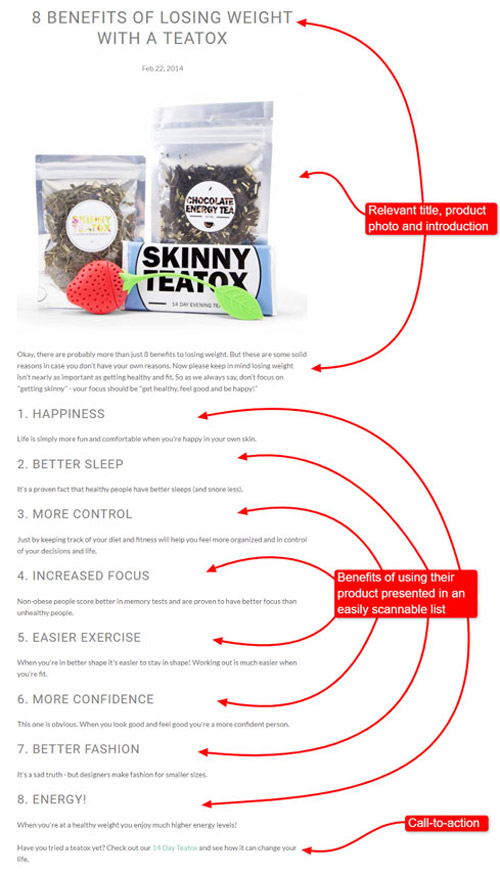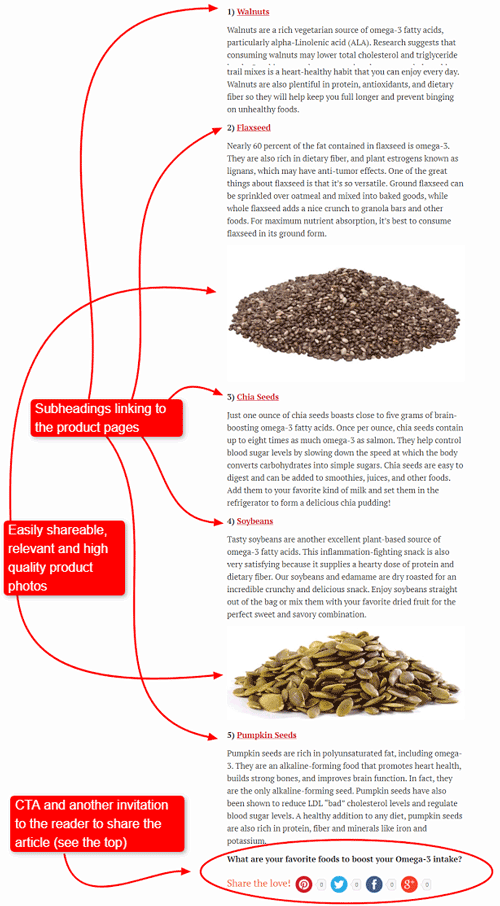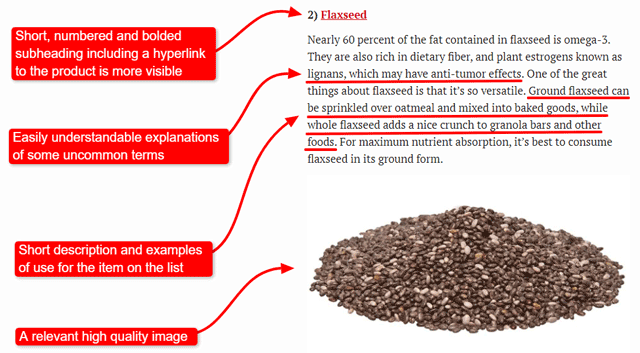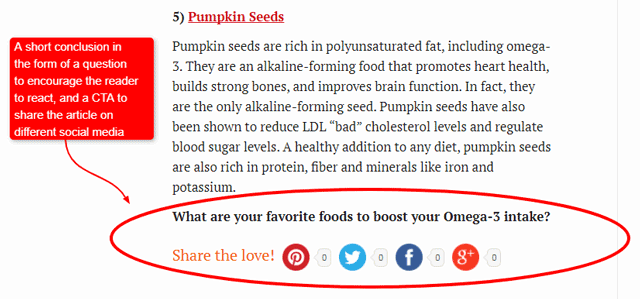
List-based blog posts have been popular since the very beginning of the Internet and are very easy to create. Not only are they easy-to-read and skim-friendly, but their format also makes it easy for readers to form opinions, comment on them, and share them.
According to this source, readers nowadays have grown extremely nit-picky about what they should read. They want to know:
- What they’re going to read
- How many minutes it takes to read the article
- Whether that article will make a dent in their lives
And nothing could beat listicles when it comes to fulfilling these 3 things.
For all these reasons, list-based blog posts are great tools for any eCommerce business. Whether you are creating a list of your best products, a list of how to use your products, or a list of why people should use your products, your readers will enjoy and learn a lot from your article.
You wonder how come they’re so popular?
The way we’re presented with information changes the way we process and interpret it. Lists let us process complicated information spatially, transforming it from cluster to linear progression.
To find out more reasons, refer to https://www.wired.com/2014/01/defense-listicle-list-article/.
You may want to watch this video and take a sneak peek at the psychology behind the lists and more reasons why people find them so powerful and appealing.
Also, you may want to read the article Why Listicles Are The New Face Of Content Marketing? to find out more about the reasons behind their growing acceptance and why every business should embrace listicles as a must-have tool in its content marketing strategy.
Got it? Nice. Thus, once you start working as an eCommerce copywriter, make sure to schedule at least one list-based post into your store’s blog each week. Your employer will be grateful and you’ll see the difference yourself.
Therefore, the aim of this lesson is to help you as a future freelance copywriter learn how to create this very successful blog format from the planning phase, all the way through structuring the article, to editing and finalising it.
There are several factors that make a list-based blog post informative and interesting:
- An accurate and keyword-rich title
- Visible headers for each item arranged logically
- A conclusion that leaves a strong impact, among others
In the subsections to come, you will learn how to write your own effective list-based article. But first, let us show you and briefly analyse some example blog posts to make sure you’ve really realised what listicles are.
Here we go.
What are Listicles?
Listicle is an informal term for an article made up of a series of facts, tips, quotations, or examples organised around a particular theme.
Listicles, which may be numbered or bulleted, are particularly common in blogs and other online articles. We highly recommend that you tend to use numbers rather than bullet points for this type of articles.
Wonder why?
Fun fact: numbers in a headline are like “brain candy.”
We’re simply attracted to read them more – and some say odd numbers do ever better. To check out an example, go to https://expresswriters.com/most-readable-content-types/.
Being able to call out a number in your headline makes the piece instantly more attention-grabbing; it implies a degree of conciseness and skimmability that’s appealing to modern web users, plus serves as a tease that piques user interest.
So, listicle is a blend (a word formed by merging the sounds and meanings of two or more other words or word parts) of the words list and article.
The age of the listicle means that the form of the content we used to consume has drastically changed. To find out what led to the rise and popularity of listicles, you may read the full article http://topyaps.com/the-road-to-listicles.
In a nutshell, here’s what listicles are and how they can help one’s business:
Now, let’s check out a couple of examples of listicles.
Example #1: 8 Benefits of Losing Weight With a Teatox
This article is by an eCommerce store called Skinny Teatox. The aim of this list-based blog post is to convince readers to buy their products by enumerating its benefits. Take a look at this short and to-the-point blog post.

Example #2: 5 Foods To Increase Your Omega-3 Intake
With this list-based article, the online store Nuts enumerates products that contain Omega-3. Each item on the list links back to their online store product pages where readers can purchase the products. Take a look at it.

OK. Now that you know what listicles look like and why they’re so popular and powerful, we can move on to how they’re created. By following these phases and steps, you will be able to create a list post that will surely give your eCommerce business a boost. Ready to start?
Phase 1: Planning
During the planning phase, you already have an idea about the article title, items that you will include and the way your article will be structured. Here are some ideas on how to hone the listicle into its final form – ready for publishing.
Step 1: Identify Your Readers
Who are you writing for?
What kind of customers will be reading your posts?
Write the answers down once you have identified them and keep them in front of you as you write your listicle. It will help you with your choice of words, style and tone, making your article more readable.
When you know who your target audience is, it’s time to figure out the specific message you want to send them within your listicle.
Step 2: Identify Your Objective
What is the aim of your list?
What do you want your audience to learn and do after reading your article?
This will serve as a guide or general outline so you won’t be tempted to stray off-track with your topic. Come up with your CTA, write down your objective and come back to it if you are not sure of what to include and what not to include in your list.
So, before you start writing and after you identify your readers, define your big idea – your topic i.e. what message you want to communicate to your reader.
Here are some more questions to help you figure this out:
- What do I need my prospect to believe in order to click on the call to action?
- What do they need to understand/learn/know before they will convert?
- What barriers do they have to overcome to convert?
- What objections do they have to overcome to convert?
- What are they thinking about/worried about/researching/talking about before they convert on what you have to offer?
- What is the primary pain point your prospect is experiencing?
Find out more about writing blog content that converts in the article How To Write Blog Posts That Sell.
Knowing how you want to help your readers elevates your blog post from a random list of mediocre ideas to a memorable post. Therefore, always think how readers will benefit from reading your list post?
Read more in How to Write a List Post That Readers Like, Love and Share and How to Make Your Message Sticky.
Most importantly, for every article, your aim is to somehow promote the products of the online store you’re working for and provide links to the product pages or categories. You can always write any article that you can think of, but the question is:
Is that topic related to your business? Would it promote your products?
Thus, according to Top 35 Blogging Ideas That Are Guaranteed to Be Popular, you need to understand:
- What you’re selling
- To whom you want to sell, and
- What blog topics are relevant to both
If you delight your readers with your product or idea, if you provide real solutions to their problems, they’ll want to find out more. Learn how to do it successfully in 58 Ways to Create Persuasive Content Your Audience Will Love.
These tips should be kept in mind while writing list-based posts.
Now, when you know what exactly you’re writing about and to whom, it’s time to start writing, right?
Step 3: Create a Working Title
A working title is the initial title of your article as you are writing it. It doesn’t have to be perfect and may change as you go on writing but it will also serve as a guide to keep you on-topic.
Once you have finished your list, come back to this and check if the title accurately describes your list. If not, rewrite it.
It may also be helpful to write down several working titles so that you are not limited to just one.
Always include a number in your title. The bigger the number is, the more valuable it seems to your readers. For example, 55 Healthy Dinner Ideas is more likely to be clicked on than 5 Healthy Dinner Ideas.
“If blogs with numbers in their titles stand out, blogs with less rounded figures tend to stand out even more.”
A good listicle headline should do the following:
- Capture the target reader’s attention.
- Clearly define the value of the post and what information a reader will learn.
- State the quantity of information by indicating the number of items in the listicle.
Learn more in this Step by Step Guide to Writing Listicles Like a Pro and check more tips on how to write a headline the pros will envy.
After creating a working title as a starting point, you should create an outline. Let’s do it.
Step 4: Create a Template for the List
Your template or outline will serve as a guiding format of your list-based blog post. It consists of the following:
- Introduction – describes what the list is and what readers can learn from it
- Body – enumerates each item in your list, provides descriptions and examples
- Conclusion – ends the list with a reflection of what readers have learned
When creating an outline, refer to Step 2 above and carefully consider what your list is about (its topic) and what you want your readers to learn (your objective) and do (your CTA). Then, brainstorm ideas for items that should be included in the list.
To learn more about how to plan a blog post, you may refer to our lesson Blog post basics: planning (if you haven’t already).
After a thoughtful initial planning stage, structuring your listicle is what naturally follows. This is how to do it.
Phase 2: Structuring the Article
After you’ve carefully planned what your listicle will be about, it’s time to start structuring and writing it, isn’t it?
You have a head start on structuring a listicle since the format is clear – numbered sub-heads with a clear introduction and witty conclusion.
However, this means you should put the bulk of your effort into writing and researching the content. Write out a list of topics you want to cover, and narrow this list down to specific, individual subheads, each different from the previous.
Ensure you’re not repeating any points, and that there is a progression in the listicle moving toward a clear end-point. Check out another 5 tips for creating an engaging and shareable listicle.
Let’s dive a bit deeper into structuring a listicle step by step.
Step 1: Write the introduction
The introduction is what will draw in your audience to continue reading your list. Follow these steps for writing an introduction:
1. Write an opening line that catches the interest of your readers. Take a look at this example:
“If you love to grill but don’t love to stand in line at the grocery store, you will benefit from finding a great place to order some mail order steaks.”
- The opening sentence draws the reader in by empathising with them and letting them know there is useful information in the list. Nobody likes standing in line at the grocery store therefore they will want an easier alternative.
- To write a compelling first sentence, you may also ask your readers a question: “Do you love to grill but hate having to go to the grocery store and wait in line?”. Or convince them of an idea: “Everyone loves steak, but nobody likes waiting in line at the grocery store…”
2. Explain more about the list and provide simple examples, such as this one:
“With a little help from the Internet and efficient shipping services available, getting great steaks delivered to your door at an affordable price is now easy.“
- Discuss more about what the content of the list is and why it can be useful.
3. Transition into the body. For example:
“Among the huge number of online meat vendors, the five below have proven themselves to be the best mail order steaks you can eat:”
- This last line in the introduction lets readers know that they are about to read the actual list and it makes them want to keep reading. It also serves as a transition into the body of the blog post.
Remember that the introduction should be interesting and compelling enough for your readers to want to continue on to your list.
In addition, according to Copyblogger’s 3-Step Formula for Captivating Your Audience With a Few Opening Lines, in order to write a seductive opening paragraph you need to:
- Empathise with your reader’s struggle
- Promise your reader a benefit
- Provide reassurance
You may also opt to write the introduction last after you have finished writing the items on the list. Then you will know what the actual content is and it will be easier to introduce it.
Body is what follows the introductory part.
Step 2: Write the Body
The body is the meat of your list-based blog post. This is what your readers actually want to know. Make sure it is consistent with what was said in the introduction.
The list will be made up of a combination of items in bullets, numbers, headers, or paragraphs. Format it in such a way that will be the easiest to understand.
You’ve probably noticed we prefer and strongly recommend using numbers instead of bullet points in listicles. Here’s why.
Numbering each list item in a listicle helps keep things consistent, scannable, and breezable, as suggested in Kevan Lee’s article on writing listicles. Read the full article to see some fabulous tips that really work and further reading suggestions included.
It’s also mostly because “time and attention are increasingly precious in a world crowded with content, and a sign to show readers what they’re in for can be a very wise decision. A number gives readers an estimate on how much reading they’ll have to do. Smaller numbers suggest a quick, easy read while larger numbers will attract readers looking for more information or options on the topic. The longer pieces tend to get more shares though, as readers will find more value there.”
The blog post by Nuts mentioned above, 5 Foods to Increase Your Omega-3 Intake, is a good example of a list-based article. Refer to this item on their list and follow these steps for writing the body.

1. Use subheadings to make each step more visible to readers, and label them appropriately.
- In today’s busy world with thousands of distractions waiting just around the corner, most readers will – as sobering as this is – probably merely skim your content. That’s where subheadings come in.
Write every subheading for someone who won’t have time to read the whole listicle, but still wants to get an idea of what you’re writing about. Make it as funny, snappy and informative as the rest of your listicle.
For more tips read How to Create the Perfect Listicle. - In the example, Flaxseed is numbered and bolded. This makes it more visible to readers.
- Make the title of each item as short as possible. You will be talking more about the item in the description.
2. Discuss each item on the list and provide examples for each.
- Provide a detailed explanation of each item in your list – to provide value; you need to be thorough and exhaustive for all items. It depends on the purpose of your post, but you are normally asked to explain why you included the item in your list.
Make a compelling case for their inclusion and appeal to your readers why you are correct.
Read the full article 17 Ways to Write the Best Listicle Content on Your Blog for Higher Traffic to learn more. - When writing descriptions, keep in mind what your readers want to know and write in a language they will understand.
For example, the description discusses the nutrients in flaxseed and what they are for. Though it may use uncommon terms like “lignans”, it also explains what it is good for “which may have anti-tumor effects”. - The description also talks about serving suggestions for flaxseed “Ground flaxseed can be sprinkled over oatmeal and mixed into baked goods…”
3. Hyperlink to other resources.
- Hyperlinking increases visibility in search engines, making your article easier to find.
- If you are creating a list of your own products, hyperlink to your own online store. In the example, each item is linked back to the Nuts store where readers can purchase them.
4. Arrange items accordingly, following a consistent format.
- Organise items in a logical manner; either from most popular to least popular, least popular to most popular, or alphabetically. Decide on an order that will encourage your audience to keep reading.
- A consistent format also makes it easier for readers to understand.
When you’re done with the body part, it’s time to sum it up.
Step 3: Write the Conclusion
Sometimes, people get a little lazy when it comes to wrapping up lists. It’s tempting to just end it, but just because it’s a list, that doesn’t mean you should end too abruptly. Either take a moment to wrap things up, or have a great kicker (that would be your witty last line).
Refer to this whole article to see more valuable tips for writing a listicle that will get published.
There are several ways you can conclude your list-based blog post.
1. Summarise how the list has benefited your readers.
- This part of the conclusion should remind readers of what they have learned or how it can be useful to them. Write this only if you did not include it in the introduction so as not to be redundant.
2. Ask them a question or finish with a strong sentence.
- The last or only sentence in the conclusion must leave a powerful impression on readers. Ask them questions that end with question tags such as “…don’t you?” or “…isn’t it?”
- You may also ask them questions like “What are your favorite ABCD?” or “What do you think of ABCD?” This will encourage them to leave comments.
3. Include a call-to-action.
- This is your chance to ask your readers to share your article, like your store Facebook page, or follow it on Twitter, for instance.
You may also include all three of these in your conclusion. The most important thing is to leave a favourable impression and remind the readers that they have gained new knowledge through your list.
Good examples of conclusions can be found in the articles mentioned at the beginning of the lesson.
Here’s the one from 8 Benefits of Losing Weight With a Teatox:

And here’s the other one from 5 Foods To Increase Your Omega-3 Intake:

They’re very short (sometimes one-sentence conclusions) but it’s important that they leave a strong positive impression on readers. Encouraging people to react, respond, or share the content is also a good way to wrap up the article.
Therefore, never end a list-based article without a conclusion, even the shortest one. Let the readers know that they have read the entire list.
As the article we linked to at the beginning of this subsection reminds us – “listicles don’t have to be dumb”. Try to elevate the form whenever you can, by using humor, honesty, good writing, research, and originality. Compose your listicles wisely, and you’ll be publishing in no time.
In the article 5 Powerful Ways to End a Blog Post (and Fire Up Your Audience), you’ll find more valuable tips on how to write inspirational closing paragraphs illustrated with examples.
Now, you’re very close to the end of your listicle writing process. Just one more phase left, but make sure you never skip it.
Phase 3: Editing and Finalising
Read and reread your entire list-based blog post. Correct any errors you may have made and improve anything that needs improvement.
These are the tips you should always bear in mind.
1. Ask someone to read your list
- An outsider’s opinion can give you a fresh perspective of your article and will help you find more ways to improve it
2. Finalise your title
- Is your working title still in line with your list? If not, change it. Make it more accurate and interesting
- The ultimate headline formula suggested in this fabulous article goes like this: Numbers + Adjective + Target Keyword + Rationale + Promise
3. Choose an image
- This will serve as a thumbnail and click-through for your article and will appear on your blog when it is shared on social media
- Make sure that it is eye-catching but also represents your article well
- As stated in The Art of the Perfect Listicle, a listicle without images is like a swimming pool without water – useless and ugly. Ideally, you should use original high-quality images, but stock photos work in a pinch. (Follow the link to find out more advice you need to heed in your quest for the perfect listicle.)

Source: buffer.com
Congratulations! After completing this step, you’re ready for publishing! To learn more about each step within structuring, editing and finalising articles, refer to our lesson Blog post basics: writing process since it’s more detailed.
However, let’s point out some additional helpful hints specifically about listicles you may need to keep in mind.
Additional Guidelines
A few more things to remember when writing your list-based blog post are:
- Do not limit yourself to a certain number. You may decide to change it along the way
- If there are too many items in your listicle, divide them and combine those with common elements into groups
- Be wary of the length of your blog post. If you are creating a list of 10 items, do not make the description for each item too long
- Provide examples. To elaborate on each item, use examples to clearly show your readers what you are talking about
- Optimise the post for search engines. Aside from hyperlinking to other sources, create a title that is keyword-rich, placing the most important keyword as close to the beginning of the title as possible
Apart from reasons why this blog type is so popular, The Power of Listicles also brings us the following Listicle Dos and Don’ts. Check them out.
Do:
- Come up with an attention-grabbing headline for your listicle
- Choose an odd number of points for your list – they’ve been proven to perform better than even numbers
- Make that number as high as you can
- Accompany every point with an image, or if you want to make it even more fun, a GIF
- Make use of your on-page SEO skills
Don’t:
- Only create listicles for your site – you should provide a balanced mix of content types to cover all bases, including long form articles, infographics, and multimedia
- Be sloppy with the layout. Listicles are popular for their simplicity, so make sure the layout is consistent
- Add bad quality images. They are the thing that stands out the most in a listicle
- Overlook the tone of voice. Humour and personality should shine through
- Forget to share on social media
Next, the author of the article How To Write The Perfect Listicle presents some valuable tips on writing a great listicle by Thomas A.C. Murrell. Here is his advice in a nutshell:
- Keep it Short
- Keep it Visual
- Keep to One Theme
- Killer Headline or Title
- Use Odd Numbers
- Leverage Your Authority Status with Great Content
- Make it Shareable
- Write Friendly
- Provide solid, practical advice
- Use Concrete Examples
In addition, this article presents some important things to be aware of when writing in the listicle blog post format:
- While the listicle format can deliver great success, it also has the greatest competition. They are what the majority of readers expect from a blog these days, and that also means that your readers can pick and choose between various list-type blogs that suit their needs.
- Listicles still require strong planning and a content strategy. You still need a strategy to create unique content within this format and distribute it wisely.
Also, here’s some suggested reading and additional precious expert advice on writing listicles for those who want to know more (and all serious students do):
- 14 Steps To Write A Great Listicle (more valuable resources included in this article as well)
- How To Write A Listicle (a step-by-step guide)
- The 3 Types of Listicles Content Marketers Can Learn from BuzzFeed (This helps you understand the 3 primary kinds of BuzzFeed list Article formats and how they can be applied to eCommerce with several real-life examples from e-tailers utilising each listicle type to provide some inspiration.)
- How to Write a Blog Post: 16 Templates to Make It Easier (Here you can find templates for 16 top blog post formats, listicles being one of them.)
- 5 Blog Post Ideas to Bring Variety to Your Content (listicles being the first suggestion)
- 6 Foolproof Tips For Creating Video Listicles (useful since videos are massively popular on the Internet)
- The Science of Snackable: 6 Scientific Reasons Your Brain Loves Listicles
- What sets good listicles apart from the average ones?
- 5 Highly effective blog post types (Read about blog post ideas to increase traffic and social media activity, as well as about the differences and uses of two listicle variations – the super-long list post and the short-but-super-detailed list post.)
- How to Create a Listicle (7 quick tips)
- Listicles: Pro And Con (Why they’re so effective and how to make good ones.)
In Summary
Listicles are one of the most popular blog formats because of their simplicity and they are great tools for your eCommerce business. When writing listicles first try to think about the next questions:
- Who are your readers?
- What information do you want to provide for them?
Now when you have the answers to these questions you can go to the next steps:
- Come up with a good working title, and
- Make a template/outline for the list
These will serve as your guiding tool for writing an awesome list-based post.
Although list-based posts are very simple to write you should think about the structuring, editing and finalising very thoroughly when you decide to write one.
Firstly, when structuring the article follow these writing steps:
- Introduction
- Body
- Conclusion
After you are done with writing:
- Reread your article several times in order to correct possible mistakes or to make some changes if necessary
- Finalise the title
- Find the best images you can
Moreover, it is crucial not to limit yourself in any way and try to provide the article with the best possible examples. By following the above-mentioned steps you’ll get a great blog post your readers will enjoy. Good luck!
